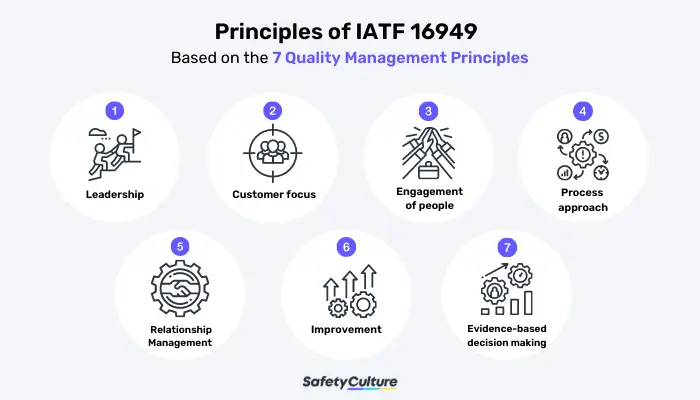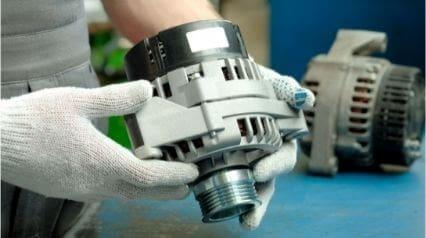What is IATF 16949?
The IATF 16949:2016, also known as IATF 16949, is a set of standards created by the International Automotive Task Force (IATF) for the automotive industry specifically. These standards aim to maintain and continuously improve the quality of automotive service and assembly parts by preventing defects and reducing waste.
Principles and Purpose

Principles of IATF 16949
The IATF is a group of manufacturers in the automotive industry who wish to provide quality products for their customers worldwide. Those in the IATF also want to constantly be improving, not only in their processes but also with their products as well, hence the creation of IATF 16949.
All the IATF members’ wishes are reflected in IATF 16949. Specifically, this aims to improve the systems and processes in place to manage quality in order to increase customer satisfaction. In the process, the improvements should then reduce problems and risks, focusing more on avoiding errors, achieving zero defects, and consistently meeting customer-specific requirements.
As a quality management system (QMS) standard, IATF 16949 also follows the 7 quality management principles:
- Leadership
- Customer focus
- Engagement of people
- Process approach
- Relationship management
- Improvement
- Evidence-based decision making
Relationship Between ISO 9001 and IATF 16949
While many automotive companies look to IATF 16949 for their quality assurance needs, these standards cannot stand alone. Rather, the IATF 16949 is based on the International Organization for Standardization’s ISO 9001.
The ISO 9001 follows the same seven quality management principles as IATF 16949 does. However, the main difference between ISO 9001 and IATF 16949 is that ISO 9001 is the general framework for QMS that is followed by many, regardless of industry. Heavily based on ISO 9001, the IATF 16949 is an independent set of standards which provides specific guidelines for those in the automotive industry only. While an independent set of standards, the IATF 16949 cannot be fully implemented or followed without ISO 9001.
Importance of Following IATF Standards
Those in the automotive industry need to follow both IATF and ISO standards. This is not only for compliance but also for ensuring that all automotive parts and products are of high quality at par with international standards and are safe for use. ISO and IATF standards put quality and safety at the forefront of their guidelines, ensuring that all final products would be safe for both the customers and the businesses producing them.
Following IATF standards is especially necessary to gain certification. IATF themselves do not offer IATF accreditation, but there are third-party auditors or accreditation bodies recognized by the IATF that do the certification for them. Each IATF certificate is valid for three years, and at the end of those years, business owners will be required to file for a new one.
Having a certificate can also be very beneficial to a business in terms of attracting customers and potential business partners. Being IATF-certified can show that the business owners and their employees care about quality and that they follow all safety procedures before, during, and after production. This is very important in business-to-business transactions as well, some businesses choose to only transact with IATF-certified businesses to assure themselves of the quality of their products.
Improve your GRC management
Simplify risk management and compliance with our centralized platform, designed to integrate and automate processes for optimal governance.
Explore nowHow to Comply with IATF 16949
The best way to comply with IATF 16949 and perform audits for compliance is by using checklists. Often, third-party IATF auditors and accreditors use checklists to check if automotive businesses are following IATF standards.
Additionally, these auditors also use checklists to ensure the automotive company’s necessary documents are being submitted on time and in the right formats. Checklists can also be used when reapplying for IATF certification once the previous certification has expired.
Some of the documents that auditors and accreditors require from companies include:
- quality policies and manuals;
- quality objectives;
- management plans for product safety;
- contingency plans for emergencies;
- records of customers’ feedback; and
- calibration records.
Typically, auditors and accreditors use traditional checklists. However, digital checklists are becoming increasingly popular for use due to the ease of use and value-add they offer.
Create your own IATF Audit Checklist
Build from scratch or choose from our collection of free, ready-to-download, and customizable templates.
Browse IATF Audit ChecklistsSafetyCulture for IATF Compliance
Consider using SafetyCulture (formerly iAuditor) to help you with complying with IATF 16949 requirements. SafetyCulture is a digital checklist app that you can use to ensure the safety and quality of your products and services.
SafetyCulture is easily accessible from any internet browser, Android device, and iOS device, making it usable for all. You can also digitize your existing Word, PDF, and Excel checklists in the app, allowing you to keep everything in one place.
With SafetyCulture, you can also:
- Use pre-made templates from the Public Library
- Schedule both repetitive and one-time inspections on worksites
- Report concerns by raising Issues, assigning Actions, and sending a Heads Up
- Generate and use QR codes to conduct faster inspections
- Store all checklists and accomplished checklists in the cloud and access them later
- Create analytical reports to see where you are most compliant and what you need to work on




